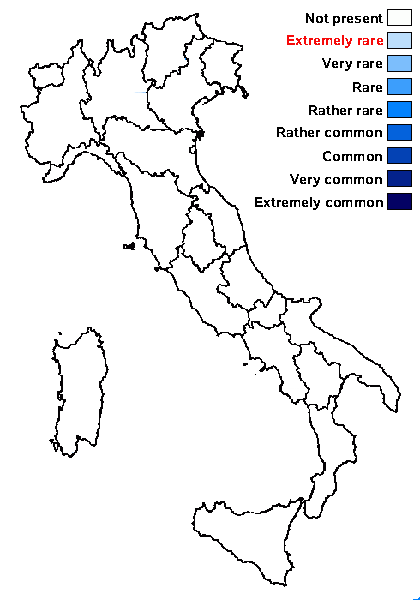Lobothallia uxoris (Werner) Cl. Roux
in Roux & al., Bull. Inf. Ass. Franç. Lichén., 47, 1: 30, 2022.. Basionym: Lecanora uxoris Werner - Bull. Soc. Sci. Nat. Phys. Maroc, 18, 2: 130, 1938.
Synonyms:
Distribution:
Description: Thallus crustose, episubstratic, continuous to areolate, white, whitish grey or cream-coloured, often pruinose, forming up to 15 cm wide patches, sometimes delimited by a pale to grey prothallus, the areoles 0.6-3.5 mm wide, angular or rounded, flat to strongly convex. Sometimes the thalli become detached from the phorophyte, finally falling to the ground and developing whitish to yellow-brown, 1-3 mm long rhizomorph-like outgrowths. Cortex 15-65(-125) µm thick, paraplectenchymatous, with coarse crystals partially dissolving in K, sometimes brownish in upper part, overlain by an up to 20 µm thick epinecral layer; medulla white, up to 310(–515) µm thick, paraplectenchymatous in upper part to loose in lower part, filled with coarse crystals, I-. Apothecia lecanorine-aspicilioid, 1 to several per areole, up to 2.1 mm across, simple or composite, round to slightly angular by mutual compression, sometimes distinctly elongate, with an initially concave, then flat to slightly convex, dark brown to black but often white-pruinose disc and an irregularly lacerated, raised thalline margin. Thalline exciple up to 200 µm wide; proper exciple up to 155 µm wide, but sometimes much reduced, the outer rim brown, paraplectenchymatous, the inner cells radiating, usually hyaline; epithecium up to 40 µm high, dark brown to slightly olivaceous, finely granular on the surface, N+ light emerald green; hymenium colourless, (80-)90-140(-160) µm high; paraphyses simple to rarely branched and anastomosing, moniliform in upper part, with 1-7 rounded cells at the tips, the apical cells 3-9 µm wide; hypothecium colourless, 20-110(-125) µm high, usually not subtended by an algal layer. Asci 8-spored, clavate, the apical apparatus thick, K/I-, with a fuzzy amyloidal coat. Ascospores 1-celled, hyaline, ellipsoid to broadly ellipsoid, (10-)12-17 x 7-12 µm, thin-walled. Pycnidia common, immersed, uni- to multilocular, sometimes clustered. Conidia bacilliform, straight, 5-8 x 0.75-1.25 µm. Photobiont chlorococcoid. Spot tests: thallus K-, C-, KC-, P-, UV-. Chemistry: thallus without lichen substances.
Note: a species growing on the bark of conifers (Cedrus, Juniperus, Pinus) in dry areas, known from Morocco, Algeria, the Iberian Peninsula and Turkey; to be looked for in Italy, especially in Sardinia.
Growth form: Crustose
Substrata: bark
Photobiont: green algae other than Trentepohlia
Reproductive strategy: mainly sexual
Subcontinental: restricted to areas with a dry-subcontinental climate (e.g. dry Alpine valleys, parts of Mediterranean Italy)

Predictive model
Growth form: Crustose
Substrata: bark
Photobiont: green algae other than Trentepohlia
Reproductive strategy: mainly sexual
Subcontinental: restricted to areas with a dry-subcontinental climate (e.g. dry Alpine valleys, parts of Mediterranean Italy)

Predictive model

